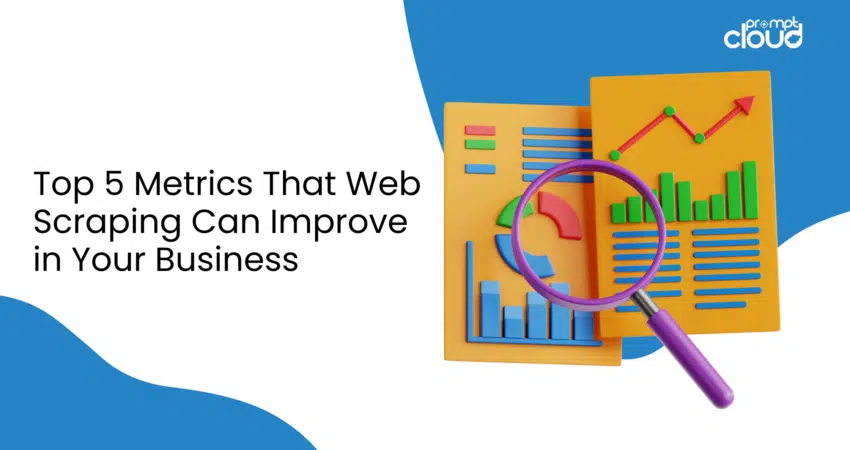
In the modern business landscape, data is a vital asset that can provide a significant competitive edge. The ability to efficiently collect, analyze, and act upon data has become crucial for success. Web scraping has emerged as an indispensable tool, empowering businesses to gather extensive information from the web. By harnessing web scraping, companies can enhance critical performance metrics, fostering growth and enabling smarter decision-making. In this article, we delve into the top five metrics that web scraping data can dramatically improve for your business.

#1: Market Trends and Consumer Sentiment
Understanding market trends and consumer sentiment is crucial for businesses looking to stay ahead of the competition. Traditional methods of gathering this information, such as surveys and focus groups, can be time-consuming and limited in scope. They often provide a snapshot of opinions that can quickly become outdated, especially in fast-moving industries.
Improvement Through Web Scraping:
Web scraping data enables the collection of real-time data from social media platforms, forums, review sites, blogs, and news outlets. By continuously monitoring and analyzing this data, businesses can gain a dynamic and comprehensive understanding of market trends and consumer sentiment. Here’s how web scraping data can enhance this metric:
1. Social Media Monitoring
Web scraping tools can extract data from social media platforms, capturing mentions, hashtags, and user comments. For instance, a fashion retailer can scrape Twitter for trending hashtags related to fashion to identify emerging styles and preferences. By analyzing these trends, the retailer can adjust its inventory and marketing strategies to align with current consumer interests.
2. Customer Reviews Analysis
Web scraping data allows businesses to aggregate and analyze customer reviews from platforms like Amazon, Yelp, and TripAdvisor. This helps in understanding customer satisfaction and identifying common pain points.
3. Competitive Benchmarking
By scraping competitor websites and industry blogs, businesses can track the strategies and product offerings of their competitors. This data can reveal market positioning and identify gaps in the market that the business can exploit.
4. Consumer Forums and Q&A Sites
Web scraping data can extract discussions from forums like Reddit or Q&A sites like Quora, where consumers often discuss their experiences and preferences in detail.
5. Sentiment Analysis
Advanced web scraping tools can incorporate sentiment analysis to gauge the overall mood of consumer conversations. Positive, negative, and neutral sentiments can be quantified to provide a clearer picture of consumer attitudes.
#2: Competitive Pricing Analysis
Pricing strategy is a critical component of business success. To remain competitive, businesses must constantly monitor and adjust their pricing in response to market changes. Traditional methods of price monitoring, such as manual checks and third-party reports, can be slow and prone to inaccuracies.
Improvement Through Web Scraping Data:
Web scraping tools can systematically gather real-time pricing information from competitor websites, e-commerce platforms, and online marketplaces. By analyzing this data, businesses can identify pricing trends, optimize their pricing strategies, and ensure they remain competitive.
1. Real-Time Price Monitoring
Web scraping data can be used to continuously monitor competitor prices and availability, providing up-to-date information that helps businesses react quickly to market changes.
2. Dynamic Pricing Strategies
With real-time data, businesses can implement dynamic pricing strategies that adjust prices based on demand, competition, and other factors. This ensures optimal pricing at all times.
3. Identifying Price Trends
Analyzing scraped data over time can reveal trends and patterns in competitor pricing. Businesses can use these insights to forecast future pricing moves and adjust their strategies accordingly.
4. Price Disparity Detection
Web scraping can help identify significant price disparities between different regions or platforms, enabling businesses to adjust their pricing to maximize profits.
5. Competitor Promotion Analysis:Web scraping data can track not just prices but also promotions, discounts, and special offers that competitors are running. This helps businesses to understand the competitive landscape better and plan their own promotions effectively.
6. Stock Availability Insights
In addition to prices, web scraping can provide insights into stock levels of competitors. Knowing when competitors are out of stock on key items can help businesses adjust their pricing and marketing strategies to capture unmet demand.
#3: Product Development and Innovation
Innovative product development requires a deep understanding of market needs and gaps. Identifying opportunities for new products or enhancements to existing offerings can be challenging without comprehensive market insights. Traditional methods such as focus groups and surveys can be limited in scope and may not capture the full range of consumer opinions and emerging trends.
Improvement Through Web Scraping:
By scraping product reviews, customer feedback, and industry forums, businesses can uncover valuable insights into consumer preferences and pain points. This data can inform product development, helping companies create offerings that better meet market demands.
1. Analyzing Product Reviews
Web scraping can collect extensive product reviews from e-commerce sites like Amazon, eBay, and specialized review platforms. These reviews provide firsthand insights into what customers love and dislike about existing products.
2. Gathering Customer Feedback
In addition to reviews, web scraping data can extract customer feedback from social media, blogs, and forums where users discuss their experiences and preferences.
3. Monitoring Industry Forums
Industry-specific forums and discussion boards are rich sources of detailed feedback and innovative ideas shared by enthusiasts and experts.
4. Identifying Market Gaps
Web scraping can help identify gaps in the market by analyzing the availability and features of products offered by competitors. This can reveal underserved segments or unaddressed needs.
5. Tracking Emerging Trends
By scraping data from trend-setting websites, blogs, and social media influencers, businesses can stay ahead of emerging trends and innovate accordingly.
6. Enhancing Existing Products
Continuous improvement of existing products is essential for maintaining customer satisfaction and competitive edge. Web scraping data can provide ongoing feedback and suggestions from users.
#4: Digital Marketing Effectiveness
Effective digital marketing requires a thorough understanding of what resonates with your target audience. Without accurate data, marketing campaigns can miss the mark, leading to wasted resources and missed opportunities. Traditional marketing analytics methods often fall short in providing comprehensive, real-time insights into competitor activities and audience engagement.
Improvement Through Web Scraping:
Web scraping data allows businesses to gather data on competitors’ marketing strategies, including content, keywords, and ad placements. Analyzing this information can reveal successful tactics and identify gaps in your own strategy. Additionally, scraping social media and engagement metrics helps track the performance of your campaigns in real time, enabling data-driven adjustments that enhance overall marketing effectiveness.
1. Competitor Content Analysis
Web scraping data can collect data on the types of content that competitors are producing and how it performs. This includes blog posts, videos, infographics, and social media content.
2. Keyword Research and SEO Optimization
Scraping data from search engines and competitor websites can provide valuable insights into effective keywords and SEO strategies.
3. Ad Placement and Strategy Insights
Web scraping can reveal where competitors are placing their ads, what types of ads they are using, and the frequency of their ad campaigns.
4. Social Media Performance Tracking
Web scraping can collect data on social media engagement metrics, such as likes, shares, comments, and follower growth. This helps businesses understand which types of content are most effective on different platforms.
5. Real-Time Campaign Monitoring
Scraping real-time data from various digital channels allows businesses to monitor the performance of their marketing campaigns continuously and make necessary adjustments promptly.
6. Influencer Marketing Insights
Web scraping can help identify influential figures within your industry and analyze their impact. By understanding which influencers resonate with your target audience, you can make more informed decisions about partnerships.
#5: Customer Acquisition and Retention
Customer acquisition and retention are fundamental to business growth. Understanding where and how to attract new customers while keeping existing ones engaged is essential for sustained success. Traditional methods of gathering customer insights, such as surveys and focus groups, can be limited in scope and timeliness.
Improvement Through Web Scraping:
Web scraping provides insights into customer behavior, preferences, and engagement patterns. By analyzing this data, businesses can identify high-potential customer segments, tailor their marketing efforts, and create personalized experiences that foster loyalty. Furthermore, monitoring online reviews and feedback allows companies to address issues promptly, improving customer satisfaction and retention rates. Here’s how web scraping can enhance customer acquisition and retention with specific examples:
1. Identifying High-Potential Customer Segments
Web data scraping can help identify demographic and behavioral patterns among potential customers, allowing businesses to target their marketing efforts more effectively.
2. Tailoring Marketing Efforts
Scraping data from competitors and industry websites can provide insights into what marketing strategies are working best. This information can be used to refine and tailor your own marketing efforts.
3. Creating Personalized Experiences
Web scraping data can gather detailed information about individual customer preferences and behaviors, enabling businesses to create personalized experiences that drive engagement and loyalty.
4. Monitoring Online Reviews and Feedback
Web scraping can systematically collect reviews and feedback from various platforms, allowing businesses to monitor customer sentiment and address issues promptly.
5. Engaging with Customers on Social Media
Web scraping data can help businesses monitor and engage with customers on social media platforms, responding to comments and messages in real-time to build stronger relationships.
6. Analyzing Churn and Retention Patterns
Web scraping can analyze customer behavior to identify patterns that lead to churn. Understanding these patterns allows businesses to take proactive measures to retain customers.
Conclusion
Web data scraping is a transformative tool that can significantly enhance key business metrics. By leveraging the power of web scraping data, companies can gain real-time insights into market trends, optimize pricing strategies, drive product innovation, improve digital marketing effectiveness, and boost customer acquisition and retention. At PromptCloud, we specialize in providing comprehensive web data scraping solutions tailored to your business needs. Harness the full potential of web data scraping and drive your business forward with data-driven precision.
For more information on how web data scraping can benefit your business, explore our suite of web scraping services designed to deliver actionable insights and measurable results.




















